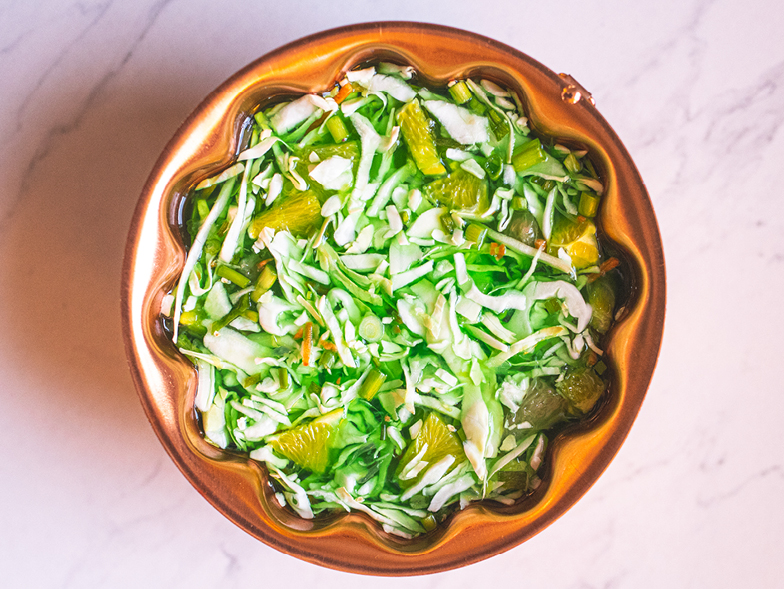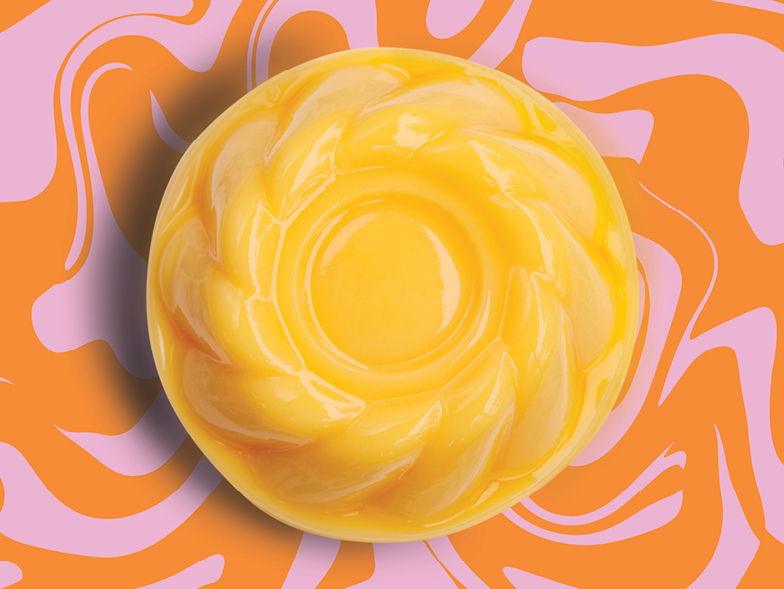Photos by Getty unless noted
The nostalgia of Jell-O connects us all to our history, both personal and collective.
My grandma Foof (named for her inability to whistle) wasn’t much of a cook, but she had her specialties. Blintz casserole—two pans of blueberry and two pans of cheese—was a staple of weekend brunches at my grandparents’ sprawling midcentury home. And beside the custardy blintz soufflés was always a gelatin mold in all its glossy, wiggly glory. There was a whole procedure to unmold it that involved hot water and my grandma giving a live play-by-play as to the status of the congealed goo’s eventual descent onto the fancy china. My grandma would yell a joyous “Yay!” and clap her hands. As a kid, there was nothing more exciting.
Generations of people have their own nostalgic stories about Jell-O—its invention and ultimate ubiquity are woven into the fabric of America. In fact, its transformation from elitist food of high society to a staple of the 1960s family table follows the thread of history through the industrialization of food production, two world wars, and shifting expectations of women in a postwar kitchen.

© Shelley Goldstein
Gelatin for the elite
Gelatin showed up on the scene way back in medieval Europe. Long before the advent of the instant Jell-O we know today, making gelatin dishes was an extremely time-consuming process because collagen had to be rendered from animal bones and then clarified. Gelatin dishes also signaled wealth and a kitchen staff. The same held true when gelatin made its way to the American colonies. At Monticello, the primary estate of Thomas Jefferson, wine jelly made an appearance on the menu when hosting guests.
Gelatin in an instant
Steam locomotive inventor Peter Cooper experimented with large sheets of gelatin, grinding them into a powder and dubbing it “Portable Gelatin.” It was revolutionary—all one needed to make gelatin was to add hot water. Though his patent was approved, the product didn’t exactly take off, perhaps because Cooper was more interested in producing glue. But fifty-two years later, in 1897, carpenter and cough syrup producer Pearle Bixby Wait created a fruit-flavored dessert that his wife, May, dubbed Jell-O. It was a combination of the words gelatin and jelly, and the “O” was added as a common practice in product naming at the time.
After an underfunded and unsuccessful marketing attempt, Wait sold the Jell-O trademark to the Genesee Pure Food Company. The company capitalized on the food-advertising themes at the time, which prioritized food purity, hygiene, sanitation, and scientific production. The ethos of women’s labor mirrored these ideas of cleanliness and efficiency. There was no better time for the concept of instant gelatin to launch. And launch it did, as the company saw sales take off in 1902.

© Shelley Goldstein
Gelatin salads abound
Ladies’ Home Journal and other popular magazines at the time ran ads for Jell-O, touting it as “America’s Favorite Dessert.” The ads were incredibly successful, driving up sales and even spurring entire Jell-O cookbooks. Genesee also hired a then-unknown artist named Norman Rockwell to illustrate scenes of their product. In 1924, the Genesee Pure Food Company rebranded as the Jell-O Company.
During the Great Depression, Jell-O was a cheap source of protein and a way to make food look visually appealing. It also made use of the fresh fruits and vegetables that were gaining in popularity at the time.
The instant and processed food products that had been manufactured out of necessity during the war had changed the landscape of food preparation, and advertisers continued to use marketing ideas of efficiency to sell Jell-O. But efficiency collided with an expectation that housewives should put more care into the meals they were preparing. To bridge this contradiction, women focused on presentation and extra ingredients, like adding cream into the gelatin to create an opaque layer or making a frosting of shrimp and mayonnaise. And the shaped molds made it easy to create impressive-looking displays with minimal effort. To match the trend, Jell-O rolled out flavors like lime, celery, mixed vegetable, and tomato.

Gelatin finds its home
By the 1970s and 1980s, sugar was being looked at as unhealthy, and Jell-O salads began to fade. Women were entering the workforce in growing numbers, and gelatin-based salads took too long to prepare. Jell-O began focusing on desserts and snacks, and that trend continues to this day, with over 420 million boxes of Jell-O gelatin and over one billion Jell-O cups being sold in the United States per year.
Jell-O is so much a part of history that a museum devoted entirely to this jiggly marvel opened in 1997 in Le Roy, New York, the same town where Pearle Wait lived. Old recipes passed down from generation to generation led one woman to create a blog of midcentury Jell-O recipes that she tested and tasted to varying degrees of horror or delight.
Even though I only ate the top two layers of my grandma’s Jell-O, picking around the unappetizing bits of fruit cocktail carefully suspended in the bottom layer, I miss the ritual of her molds, the shared bonding of a task at hand, and her delight when the wiggly mass slid its way out of the green plastic ring. The sight of Jell-O is now inextricably entwined with my memory of her, and it is this connection that will ensure gelatin will be introduced to generations to come.
>>> Read full article>>>
Copyright for syndicated content belongs to the linked Source : AmericanLifestyleMag – https://americanlifestylemag.com/holiday-entertaining/entertaining/congealed-connections/






























